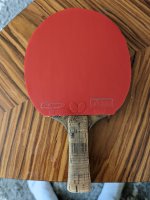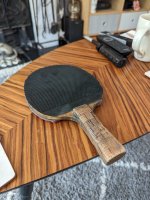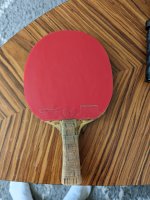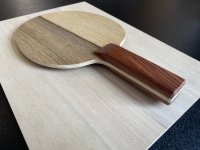This user has no status.
This user has no status.
Member
Hi folks 🙂
I'm currently looking for TT players who would be willing to act as potential play-testers for me -- I'm hoping that some of you good folk on TTDaily might be interested.
The only major requirement I have is that any play testers must currently & regularly use:
- either a one ply blade of any variety,
- or a blade of any size, make or variety that has Hinoki somewhere in its overall make-up.
I'm currently developing several all-new lines of blades (both one plys and multi-plys), which are being made from an all-new and very obscure species of table tennis wood.
So far as I know, nobody has ever used this particular wood in a table tennis blade before (or at least, not in any mass-produced ones anyway) ...because if they had, all of us would already know about this stuff.
This new and novel wood I'm using is frankly pretty amazing - it has a unique playing vibe all of its own.
To my mind however, the closest like-for-like existing match for this particular timber (once it's fully dried and gone through its pre-treatments) would have to be either Hinoki or cypress.
This is why I'm asking any Hinoki fans out there to reach out and get in touch - they have the necessary basis for comparison that I'm after.
The same thing goes re: one-ply users in general (the first new blade for testing off the block is going to be a one-ply).
The best way for me presently to describe the feel of this wood in a blade (to someone who's never seen it) is to compare it to your 'typical' Hinoki / cypress one ply. (I know there's really no such beast, but hopefully you can understand what I'm getting at)
This wood has a reasonably similar-ish playing feel to Hinoki overall, and the feedback / vibration levels in a one-ply feel about the same as well.
(If I had to be more specific, the few Hinoki one-plys I've tried all felt buttery smooth... while this stuff feels refined, but also somehow seems a little bit more 'zingy' - not in its vibration, but in its response time between impact and the ball leaving the blade... if that makes any sense to you).
Both woods are roughly the same weight, with Hinoki having a very slight edge in this department (this stuff has proved to be maybe 2-6 grams heavier per blade on average so far -- so it's a trifle heavier than hinoki, but not by very much).
So far, this wood has also shown similar spin and springiness levels to Hinoki, and that's in both one-ply and multi-ply blade applications. It seems to flex about the same as Hinoki too, though this may well change as my designs are further developed.
I'd like to say that this stuff is just as fast as Hinoki, but I'm currently in two minds about that one...
One part of me says the two woods are approximately the same speed, while the other half says this new stuff is without doubt, definitely a good bit faster!)
(NB: I'm a Hinoki one-ply fan myself here folks so I appreciate the enormity of what I'm saying. But I still stick by that perception regardless. Without hyperbole, the power of this wood in a one-ply is just staggering.)
In my personal (and by definition limited) experience, these new one-ply blades are the fastest blades I've ever used, seen, or heard of - regardless of their thickness. Nothing I have done to this wood so far seems to slow it down very much.
(In fairness, I must also admit I'm biased as hell though when it comes to this new wood. Please don't take my word for it re: its speed, as I've lost all perspective through being too close to this project in general. I'm actually looking to my play-testers to confirm or deny my suspicions on this point).
The one area where these two woods differ most clearly however, is in their respective strength to weight ratios.
Without doubt, this new wood is much, MUCH stronger per gram and/or per mm of thickness than Hinoki - frankly it doesn't even come close.
Unlike Hinoki and cypress, this new wood is quite fast growing, which means it's grain pattern is not remotely the same as Hinoki -- the grain actually looks just like a typical piece of hardware store lumber.
The differences in density and strength between the early and late wood with this wood (ie: the bits that make up a tree's rings) are very small, whereas with Hinoki, there's huge variations in strength between each consecutive ring of wood grain.
This is the reason why even a 10mm thick Hinoki one ply can split vertically along the grain pretty easily if it hits the table. It's splitting along a genetic weak-spot in the timber, through the layer of weaker wood that's sandwiched between two far denser grain rings.
Whereas, during my initial testing, I checked the strength of my personal 9.1mm one-ply blade, by literally, deliberately, and repeatedly tossing it onto a concrete floo,r from head height... And I'm six foot one!
I'm not making that up! I did this horrible thing to prove to myself this wood was really as strong as our test numbers told me it was.
I chucked my own personal blade onto a bare concrete floor twenty consecutive times, with my own hands, just to proves point to myself.
Yes the wood dented pretty badly on its edges... but it didn't break, snap, crack or splinter.
Ten months later, that same blade is still in one piece, still going strong, and I still play comp with it every week.
A 6.5mm one-ply blade made from Hinoki would be at huge risk of snapping, or warping, or both. But so far with my test one-ply blades, I've taken this stuff down to 6.0mm thick on the button. While it's a very flexy and somewhat weird-feeling at this thickness, it's still an eminently playable (and fast) one ply blade.
That being said, I've determined that 6.0mm one-ply blades - while being achievable - is just too thin, as you don't get a decent blade at that thickness -- it flexes and twists too much under load.
6.7mm however is a far more realistic minimum thickness for it, as it's far more useable... which would make it about as thick as a viscaria (Tenergy 05s on your one ply anybody? I've actually tried it and trust me, it's loads of fun!! 😎)
In my professional opinion, 7.0 mm is its ideal minimum thickness for this wood in a one ply, with the upper limit being 9.1mm. Any thicker than this and not only would it be too fast to control (and too heavy to use being over 100gm as a bare blade) but it's also becomes a health and safety issue. If the ball misses the table and hits someone, you're gonna tear their head off.
I'll be looking for critical honest feedback on these blades from my testers, so I need players who can be objective, measured, reasonable and realistic in their critiques.
I can't afford to pay anyone for their time as a blade tester either I'm very sorry - I'm basically looking for curious volunteers who have time, experience and objectivity to offer.
I can however look after you with a massive discount if you happen to like a test blade enough to want to buy it. Plus if you do decide to buy a test blade, you will be getting yours at least six months before anybody else. Hopefully it will be a collector's item one day.
More info is available on request - either send me a DM, or post your questions in this thread below. I promise to answer them as fully as I can, and all feedback and comments are welcome.
But please folks... please don't ask me what species of wood it is.
Everybody who has tried this stuff out so far keeps asking me that ...usually within the first three minutes of trying it. It's frustrating, as it's one piece of information I simply cannot disclose.
For want of a better options, I'm simply gonna calling the stuff Wakkiwood™, for obvious reasons.
(NB: I actually wanted to call it "That crazy, silly, springy-as, ball-thwacking timber from HELL!" Frankly that seemed the most appropriate option. ...but they'd never grant me a trademark over that one -- besides which, it doesn't fit on the packaging.)
Thanks for reading everyone! Hope to hear back from a few of you eventually, and in the mean time I'll see you 'round the tables.
Kind regards,
Shannon
Owner & Operator
Wakkibat: TT Bladesmiths & Equipment
Perth Western Australia
I'm currently looking for TT players who would be willing to act as potential play-testers for me -- I'm hoping that some of you good folk on TTDaily might be interested.
The only major requirement I have is that any play testers must currently & regularly use:
- either a one ply blade of any variety,
- or a blade of any size, make or variety that has Hinoki somewhere in its overall make-up.
I'm currently developing several all-new lines of blades (both one plys and multi-plys), which are being made from an all-new and very obscure species of table tennis wood.
So far as I know, nobody has ever used this particular wood in a table tennis blade before (or at least, not in any mass-produced ones anyway) ...because if they had, all of us would already know about this stuff.
This new and novel wood I'm using is frankly pretty amazing - it has a unique playing vibe all of its own.
To my mind however, the closest like-for-like existing match for this particular timber (once it's fully dried and gone through its pre-treatments) would have to be either Hinoki or cypress.
This is why I'm asking any Hinoki fans out there to reach out and get in touch - they have the necessary basis for comparison that I'm after.
The same thing goes re: one-ply users in general (the first new blade for testing off the block is going to be a one-ply).
The best way for me presently to describe the feel of this wood in a blade (to someone who's never seen it) is to compare it to your 'typical' Hinoki / cypress one ply. (I know there's really no such beast, but hopefully you can understand what I'm getting at)
This wood has a reasonably similar-ish playing feel to Hinoki overall, and the feedback / vibration levels in a one-ply feel about the same as well.
(If I had to be more specific, the few Hinoki one-plys I've tried all felt buttery smooth... while this stuff feels refined, but also somehow seems a little bit more 'zingy' - not in its vibration, but in its response time between impact and the ball leaving the blade... if that makes any sense to you).
Both woods are roughly the same weight, with Hinoki having a very slight edge in this department (this stuff has proved to be maybe 2-6 grams heavier per blade on average so far -- so it's a trifle heavier than hinoki, but not by very much).
So far, this wood has also shown similar spin and springiness levels to Hinoki, and that's in both one-ply and multi-ply blade applications. It seems to flex about the same as Hinoki too, though this may well change as my designs are further developed.
I'd like to say that this stuff is just as fast as Hinoki, but I'm currently in two minds about that one...
One part of me says the two woods are approximately the same speed, while the other half says this new stuff is without doubt, definitely a good bit faster!)
(NB: I'm a Hinoki one-ply fan myself here folks so I appreciate the enormity of what I'm saying. But I still stick by that perception regardless. Without hyperbole, the power of this wood in a one-ply is just staggering.)
In my personal (and by definition limited) experience, these new one-ply blades are the fastest blades I've ever used, seen, or heard of - regardless of their thickness. Nothing I have done to this wood so far seems to slow it down very much.
(In fairness, I must also admit I'm biased as hell though when it comes to this new wood. Please don't take my word for it re: its speed, as I've lost all perspective through being too close to this project in general. I'm actually looking to my play-testers to confirm or deny my suspicions on this point).
The one area where these two woods differ most clearly however, is in their respective strength to weight ratios.
Without doubt, this new wood is much, MUCH stronger per gram and/or per mm of thickness than Hinoki - frankly it doesn't even come close.
Unlike Hinoki and cypress, this new wood is quite fast growing, which means it's grain pattern is not remotely the same as Hinoki -- the grain actually looks just like a typical piece of hardware store lumber.
The differences in density and strength between the early and late wood with this wood (ie: the bits that make up a tree's rings) are very small, whereas with Hinoki, there's huge variations in strength between each consecutive ring of wood grain.
This is the reason why even a 10mm thick Hinoki one ply can split vertically along the grain pretty easily if it hits the table. It's splitting along a genetic weak-spot in the timber, through the layer of weaker wood that's sandwiched between two far denser grain rings.
Whereas, during my initial testing, I checked the strength of my personal 9.1mm one-ply blade, by literally, deliberately, and repeatedly tossing it onto a concrete floo,r from head height... And I'm six foot one!
I'm not making that up! I did this horrible thing to prove to myself this wood was really as strong as our test numbers told me it was.
I chucked my own personal blade onto a bare concrete floor twenty consecutive times, with my own hands, just to proves point to myself.
Yes the wood dented pretty badly on its edges... but it didn't break, snap, crack or splinter.
Ten months later, that same blade is still in one piece, still going strong, and I still play comp with it every week.
A 6.5mm one-ply blade made from Hinoki would be at huge risk of snapping, or warping, or both. But so far with my test one-ply blades, I've taken this stuff down to 6.0mm thick on the button. While it's a very flexy and somewhat weird-feeling at this thickness, it's still an eminently playable (and fast) one ply blade.
That being said, I've determined that 6.0mm one-ply blades - while being achievable - is just too thin, as you don't get a decent blade at that thickness -- it flexes and twists too much under load.
6.7mm however is a far more realistic minimum thickness for it, as it's far more useable... which would make it about as thick as a viscaria (Tenergy 05s on your one ply anybody? I've actually tried it and trust me, it's loads of fun!! 😎)
In my professional opinion, 7.0 mm is its ideal minimum thickness for this wood in a one ply, with the upper limit being 9.1mm. Any thicker than this and not only would it be too fast to control (and too heavy to use being over 100gm as a bare blade) but it's also becomes a health and safety issue. If the ball misses the table and hits someone, you're gonna tear their head off.
I'll be looking for critical honest feedback on these blades from my testers, so I need players who can be objective, measured, reasonable and realistic in their critiques.
I can't afford to pay anyone for their time as a blade tester either I'm very sorry - I'm basically looking for curious volunteers who have time, experience and objectivity to offer.
I can however look after you with a massive discount if you happen to like a test blade enough to want to buy it. Plus if you do decide to buy a test blade, you will be getting yours at least six months before anybody else. Hopefully it will be a collector's item one day.
More info is available on request - either send me a DM, or post your questions in this thread below. I promise to answer them as fully as I can, and all feedback and comments are welcome.
But please folks... please don't ask me what species of wood it is.
Everybody who has tried this stuff out so far keeps asking me that ...usually within the first three minutes of trying it. It's frustrating, as it's one piece of information I simply cannot disclose.
For want of a better options, I'm simply gonna calling the stuff Wakkiwood™, for obvious reasons.
(NB: I actually wanted to call it "That crazy, silly, springy-as, ball-thwacking timber from HELL!" Frankly that seemed the most appropriate option. ...but they'd never grant me a trademark over that one -- besides which, it doesn't fit on the packaging.)
Thanks for reading everyone! Hope to hear back from a few of you eventually, and in the mean time I'll see you 'round the tables.
Kind regards,
Shannon
Owner & Operator
Wakkibat: TT Bladesmiths & Equipment
Perth Western Australia
Last edited:
















